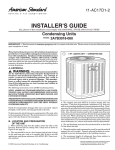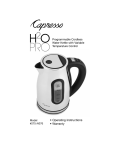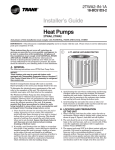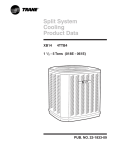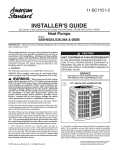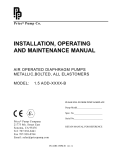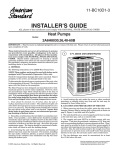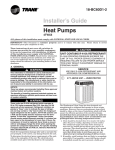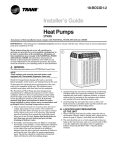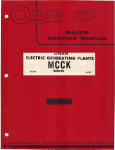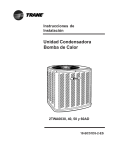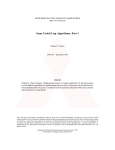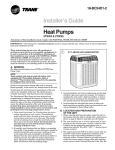Download INSTALLER`S GUIDE
Transcript
11-AC17D1-1 INSTALLER'S GUIDE ALL phases of this installation must comply with NATIONAL, STATE AND LOCAL CODES Condensing Units Models: 2A7B3018-060A1000A IMPORTANT — This Document is customer property and is to remain with this unit. Please return to service information pack upon completion of work. These instructions do not cover all variations in systems nor provide for every possible contingency to be met in connection with installation. All phases of this installation must comply with NATIONAL, STATE AND LOCAL CODES. Should further information be desired or should particular problems arise which are not covered sufficiently for the purchaser’s purposes, the matter should be referred to your installing dealer or local distributor. 1 5 FT. ABOVE UNIT — UNRESTRICTED A. GENERAL ▲ WARNING: This information is intended for use by individuals possessing adequate backgrounds of electrical and mechanical experience. Any attempt to repair a central air conditioning product may result in personal injury and or property damage. The manufacturer or seller cannot be responsible for the interpretation of this information, nor can it assume any liability in connection with its use. NOTE: AMERICAN STANDARD HAS ALWAYS RECOMMENDED INSTALLING AMERICAN STANDARD APPROVED MATCHED INDOOR AND OUTDOOR SYSTEMS. THE BENEFITS OF INSTALLING APPROVED MATCHED SYSTEMS ARE MAXIMUM EFFICIENCY, OPTIMUM PERFORMANCE AND BEST OVERALL SYSTEM RELIABILITY. Check for transportation damage after unit is uncrated. Report promptly, to the carrier, any damage found to the unit. To determine the electrical power requirements of the unit, refer to the nameplate of the unit. The electrical power available must agree with that listed on the nameplate. B. LOCATION AND PREPARATION OF THE UNIT 1. When removing unit from the pallet, notice the tabs on the basepan. Remove tabs by cutting with a sharp tool as shown in Figure 2 (see page 2). 2. The unit should be set on a level support pad at least as large as the unit base pan, such as a concrete slab. If this is not the application used please reference ALG-APG0*-EN (*latest revision number). 3. The support pad must NOT be in direct contact with any structure. Unit must be positioned a minimum of 12" from any wall or surrounding shrubbery to insure adequate airflow. Clearance must be provided in front of control box (access © 2005 American Standard Inc. All Rights Reserved panels) & any other side requiring service access to meet National Electrical Code. Also, the unit location must be far enough away from any structure to prevent excess roof run-off water from pouring directly on the unit. When choosing the location of the unit(s), sound transmission through air and refrigerant lineset should be taken into consideration. It is recommended to locate unit(s) away from areas (bedrooms, etc.) where such sound could be objectionable. 4. The top discharge area must be unrestricted for at least five (5) feet above the unit. 5. When the outdoor unit is mounted on a roof, be sure the roof will support the unit’s weight. Properly selected isolation is recommended to prevent transmission to the building structure. 6. The maximum length of refrigerant lines from outdoor to indoor unit should NOT exceed sixty (60) feet. Since the manufacturer has a policy of continuous product and product data improvement, it reserves the right to change design and specifications without notice. INSTALLER'S GUIDE 2 BASEPAN TAB REMOVAL Final refrigerant charge adjustment is necessary. Use the Charging Information on page 6 or in the outdoor unit Service Facts. 1. Determine the most practical way to run the lines. 2. Consider types of bends to be made and space limitations. NOTE: Large diameter tubing will be very difficult to rebend once it has been shaped. 3. Determine the best starting point for routing the refrigerant tubing — INSIDE OR OUTSIDE THE STRUCTURE. 7. If outdoor unit is mounted above the air handler, maximum lift should not exceed sixty (60) feet (suction line). If air handler is mounted above condensing unit, maximum lift should not exceed sixty (60) feet (liquid line). 8. Locate and install indoor coil or air handler in accordance with instruction included with that unit. NOTE: Refer to "Refrigerant Piping Software" Pub. No. 32-3312-0*, and "Refrigerant Piping Manual" Pub. No. 32-3009-0* (the position of the * denotes latest revision number). C. INSTALLING REFRIGERANT LINES ▲ CAUTION: If using existing refrigerant lines make certain that all joints are brazed, not soldered. Condensing units have provisions for braze connections. Pressure taps are provided on the service valves of outdoor unit for compressor suction and liquid pressures. The indoor end of the recommended refrigerant line sets may be straight or with a 90 degree bend, depending upon situation requirements. This should be thoroughly checked out before ordering refrigerant line sets. The gas line must always be insulated. ▲ CAUTION: In scroll compressor applications, dome temperatures may be hot. Do not touch top of compressor, may cause minor to severe burning. The units are factory charged with the system charge required when using fifteen (15) feet of rated connecting line. Unit nameplate charge is the same. 3 LIQUID LINE SERVICE VALVE 4. Provide a pull-thru hole of sufficient size to allow both liquid and gas lines. 5. Be sure the tubing is of sufficient length. 6. Uncoil the tubing — do not kink or dent. 7. Route the tubing making all required bends and properly secure the tubing before making connections. 8. To prevent a noise within the building structure due to vibration transmission from the refrigerant lines, the following precautions should be taken: a. When the refrigerant lines have to be fastened to floor joists or other framing in a structure, use isolation type hangers. b. Isolation hangers should also be used when refrigerant lines are run in stud spaces or enclosed ceilings. c. Where the refrigerant lines run through a wall or sill, they should be insulated and isolated. d. Isolate the lines from all ductwork. D. SERVICE VALVE OPERATION BRASS LIQUID AND GAS LINE SERVICE VALVES The Brass Liquid and Gas Line Service Valves are factory shipped in the seated position to hold factory charge. The pressure tap service port (when depressed) opens only to the field brazing side of the valve when the valve is in the seated position. The liquid line valve is not a back seating valve (see WARNING below). ▲ WARNING: Extreme caution should be ex- ercised when opening the Liquid and Gas Line Service Valves. Turn valve stem counterclockwise only until the stem contacts the rolled edge. (See Figures 3 and 5) No torque is required. BRASS GAS LINE BALL SERVICE VALVE The Brass Gas Line Ball Service Valve is shipped in the closed position to hold the factory refrigerant charge. The pressure tap service port (when depressed) opens only to the field brazing side when the valve is in the closed position. The Gas Line Service Valve is full open with a 1/4 turn. See Figure 4. BRAZING REFRIGERANT LINES 1. Remove lower access cover to access service valves. 2. Before brazing, remove plugs from external copper stub tubes. Clean internal and external surfaces of stub tubes prior to brazing. PAGE 2 Pub. No. 11-AC17D1-1 INSTALLER'S GUIDE 4 5 GAS LINE BALL SERVICE VALVE CAP GAS LINE SERVICE VALVE 1/4 TURN ONLY COUNTERCLOCKWISE FOR FULL OPEN POSITION VALVE STEM UNIT SIDE OF VALVE PRESSURE TAP PORT GAS LINE CONNECTION SYSTEM EVACUATION NOTE: Since the outdoor unit has a refrigerant charge, the gas and liquid line valves must remain closed. CAP 1. Upon completion of leak check, evacuate the refrigerant lines and indoor coil before opening the gas and liquid line valves. BODY 2. Attach appropriate hoses from manifold gauge to gas and liquid line pressure taps. COOLING HEATING CORE NOTE: Unnecessary switching of hoses can be avoided and complete evacuation of all lines leading to sealed system can be accomplished with manifold center hose and connecting branch hose to a cylinder of HCFC-22 and vacuum pump. 3. Cut and fit tubing, minimizing the use of sharp 90° bends. 3. Attach center hose of manifold gauges to vacuum pump. 4. Insulate the entire gas line and its fittings. 4. Evacuate until the micron gauge reads no higher than 350 microns. 5. Do NOT allow uninsulated liquid line to come in direct contact with bare gas line. 6. Precautions should be taken to avoid heat damage to the pressure tap valve core during brazing. It is recommended that the pressure tap port valve core be removed and a wet rag wrapped around the valve body. 5. Close off valve to vacuum pump and observe the micron gauge. If gauge pressure rises above 500 microns in one (1) minute, then evacuation is incomplete or system has a leak. 6. If vacuum gauge does not rise above 500 microns in one (1) minute, the evacuation should be complete. NOTICE: Use care to make sure that no moisture enters pressure tap port, while wet rag is being used. 7. With vacuum pump and micron gauge blanked off, open valve on HCFC-22 cylinder and charge refrigerant lines and indoor coil with vapor to tank pressure of HCFC-22 supply. NOTICE: Precautions should be taken to avoid heat damage to basepan during brazing. It is recommended to keep the flame directly off of the basepan. NOTE: DO NOT VENT REFRIGERANT INTO THE ATMOSPHERE. 7. Use a Dry Nitrogen Purge and Brazing Alloy without flux when brazing the field line to the copper factory connection. Flow dry nitrogen into either valve pressure tap port, thru the tubing and out the other port while brazing. 8. Braze using accepted good brazing techniques. LEAK CHECK IMPORTANT: Replace pressure tap port valve core before attaching hoses for evacuation. After the brazing operation of refrigerant lines to both the outdoor and indoor unit is completed, the field brazed connections must be checked for leaks. Pressurize through the service valve ports, the indoor unit and field refrigerant lines with dry nitrogen to 350-400 psi. Use soap bubbles or other leakchecking methods to see that all field joints are leak-free! If not, release pressure; then repair! Pub. No. 11-AC17D1-1 8. Close valve on HCFC-22 supply cylinder. Close valves on manifold gauge set and remove refrigerant charging hoses from liquid and gas pressure tap ports. NOTE: A 3/16" Allen wrench is required to open liquid line service valve. A 1/4" Open End or Adjustable wrench is required to open gas line valve. A 3/4" Open End wrench is required to take off the valve stem cap. 9. The liquid line shut-off valve can now be opened. Remove shut-off valve cap. Fully insert hex wrench into the stem and back out counterclockwise until valve stem just touches rolled edge (approximately five [5] turns) observing WARNING statement on page 2. See Figure 3. 10. Replace liquid service pressure tap port cap and valve stem cap. These caps MUST BE REPLACED to prevent leaks. Replace valve stem and pressure tap cap finger tight, then tighten an additional 1/6 turn. PAGE 3 INSTALLER'S GUIDE 6 PIN IDENTIFICATION TEST_COMMON If refrigerant lines are longer than 15 feet and/or a different size than recommended, it will be necessary to adjust system refrigerant charge upon completion of installation. See page 6 and unit Service Facts. E. ELECTRICAL CONNECTIONS FRC_DFT 12. The gas valve is now open for refrigerant flow. Replace valve stem cap to prevent leaks. Again, these caps MUST BE REPLACED to prevent leaks. Replace valve stem and pressure tap cap finger tight, then tighten an additional 1/6 turn. See Figure 4. TST 11. The gas valve can now be opened. For a ball type gas valve, open the gas valve by removing the shut-off valve cap and turning the valve stem 1/4 turn counterclockwise, using 1/4" Open End or Adjustable wrench. See Figure 4. For brass gas line service valve opening, follow 9 and 10 above. See Figure 5. FAULT IDENTIFICATION ▲ WARNING: When installing or servicing this equipment, ALWAYS exercise basic safety precautions to avoid the possibility of electric shock. A fault condition is indicated by the flashing light on the defrost control inside the heat pump control box. 1. Power wiring and grounding of equipment must comply with local codes. In normal operation, the defrost control light will flash once each second. If the light is flashing more than once per second or not at all, refer to the service manual for that unit. 2. Power supply must agree with equipment nameplate. PIN IDENTIFICATION (See Figure 6) 3. Install a separate disconnect switch at the outdoor unit. 1. TEST_COMMON (Shorting any of the other pins to this pin causes the function of the other pin to be executed. Leaving this pin open results in the normal mode of operation.) 4. Ground the outdoor unit per local code requirements. 5. Provide flexible electrical conduit whenever vibration transmission may create a noise problem within the structure. 6. The use of color coded low voltage wire is recommended to simplify connections between the outdoor unit, the thermostat and the indoor unit. Table 1 — NEC Class II Wiring 3. FRC_DFT = Forced Defrost (Short TEST_COMMON to this pin for two (2) seconds to initiate a forced defrost. Remove the short after defrost initiates.) DEFROST CONTROL CHECKOUT 24 VOLTS Normal operation requires: WIRE SIZE MAX. WIRE LENGTH 18 AWG 150 FT b. 24V AC between R & B 16 AWG 225 FT. c. 24V AC between Y & B with unit operating 14 AWG 300 FT. 7. Table 1 defines maximum total length of low voltage wiring from outdoor unit, to indoor unit, and to thermostat. 8. Mount the indoor thermostat in accordance with instruction included with the thermostat. Wire per appropriate hookup diagram (included in these instructions). F. DEFROST CONTROL The demand defrost control measures heat pump outdoor ambient temperature with a sensor located outside the outdoor coil. A second sensor located on the outdoor coil is used to measure the coil temperature. The difference between the ambient and the colder coil temperature is the difference or delta-T measurement. This delta-T measurement is representative of the operating state and relative capacity of the heat pump system. By measuring the change in delta-T, we can determine the need for defrost. The coil sensor also serves to sense outdoor coil temperature for termination of the defrost cycle. PAGE 4 2. TST = Test (Shorting TEST_COMMON to this pin speeds up all defrost board timings.) a LED on board flashing 1 time/second. d. Defrost initiation when FRC_DFT pin is shorted to TEST_COMMON pin. If a defrost control problem is suspected, refer to the service information in control box. ▲ WARNING: Do NOT connect 24V AC to T1 (ODS-A) terminal. ODS-A thermistor WILL BE BLOWN. G. COMPRESSOR START-UP After all electrical wiring is complete, SET THE THERMOSTAT SYSTEM SWITCH IN THE OFF POSITION SO COMPRESSOR WILL NOT RUN, and apply power by closing the system main disconnect switch. This will activate the compressor sump heat (where used). Do not change the Thermostat System Switch until power has been applied for one (1) hour. Following this procedure will prevent potential compressor overload trip at the initial start-up. Pub. No. 11-AC17D1-1 INSTALLER'S GUIDE H. OPERATIONAL AND CHECKOUT PROCEDURES TROUBLESHOOTING CHART — WHAT TO CHECK CH WIT DS PEE TIONS NS . FA ESTRIC OW O.D R FL CUIT . AIR AT . CIR D I.D HE REF RICTE UPER N T S OPE RES CK STU ION TXV CULAT W IR REC AIRFLO . S . AIR O.D ED O.D SABLE T N TRIC ONDE LOAD C . RES N O N E EVAP G E AR IV ESS RCH EXC T OVE A R G E H N ERA NDERC SOR RIG S U REF RANT MPRE R O O E RIG IENT C PRESS REF E M S O FFIC U INE TUCK C AGE F T IL S VOL R CO LOW ACTO R E T M CON SFOR AN IRING L TR W TRO AGE TS CON VOLT NTAC L O W O R C O ELAY T R TAC TART OR S CON ACIT CAP ITOR RT STA CAPAC L IO RUN PR. COM ING WIR AGE LY OLT SUPP ER POW HIG HV Final phases of this installation are the unit Operational and Checkout Procedures which are found in this instruction on page 8. To obtain proper performance, all units must be operated and charge adjustments made in accordance with procedures found on page 6 and in the Service Facts. L. TROUBLESHOOTING CHART SYSTEM FAULTS I. ELECTRIC HEATERS REFRIGERANT CIRCUIT Electric heaters, if used, are to be installed in the air handling device according to the instructions accompanying the air handler and the heaters. Liquid Pressure Too High P Liquid Pressure Too Low S Suction Pressure Too High S Suction Pressure Too Low J. OUTDOOR THERMOSTAT P S P P P P BAYSEAC001 (Seacoast Kit) is available for application on units installed within one mile of salt water, including seacoasts and inland waterways. S S P S S I.D. Coil Frosting K. SEACOAST SALT SHIELD S S Liquid Refrig. Floodback TXV System An outdoor thermostat TAYSTAT250B may be field installed. For data, see wiring diagram attached to unit and instruction sheet packaged with outdoor thermostat. S S P S P P S S S S S P S P S P S S P Compressor Runs Inadequate or No Cooling S ELECTRICAL Compressor & O.D. Fan Do Not Start P P O.D. Fan Won’t Start P Compressor Hums But Won’t Start P Compressor Cycles on IOL P I.D. Blower Won’t Start P - Primary Causes P S P Compressor Will Not Start But O.D. Fan Runs S P P P P P P S P P P S P P P S P S S S P S P S S S S S P S - Secondary Causes TYPICAL FIELD WIRING DIAGRAMS Notes: 1. Be sure power supply agrees with equipment nameplate. 2. Power wiring and grounding of equipment must comply with local codes. 3. Low voltage wiring to be No. 18 AWG minimum conductor. 4. ODT-B must be set lower than ODT-A. 5. If outdoor thermostats (ODT) are not used, connect W1 to W2 and W3. 6. N/A to programmable thermostat. Pub. No. 11-AC17D1-1 LEGEND FACTORY WIRING FIELD WIRING PAGE 5 INSTALLER'S GUIDE SUBCOOLING CHARGING IN COOLING ABOVE 55°F OD AMBIENT American Standard has always recommended installing American Standard approved matched indoor and outdoor systems. All 13 SEER American Standard split systems are ARI rated with only TXV indoor systems. The benefits of installing approved indoor and outdoor split systems are maximum efficiency, optimum performance and the best overall system reliability. R-22 SUBCOOLING CHARGING TABLE LIQUID TEMP. (°F) DESIGN SUBCOOLING VALUES (°F) 8 10 12 14 LIQUID LINE PRESSURE (psi) 45 89 93 96 100 50 98 102 105 109 55 107 111 115 119 60 117 121 126 130 65 128 132 137 141 3. At start-up, or whenever charge is removed or added, the system must be operated for a minimum 20 minutes to stabilize before accurate measurements can be made. 70 139 144 148 153 75 151 156 161 166 4. Measure Liquid Line Temperature and Refrigerant Pressure at service valves. 80 163 168 174 179 85 176 182 187 193 5. Determine total refrigerant line length, and height (lift) if indoor section is above the condenser. 90 190 196 202 208 6. Determine the Design Subcool Charging Temperature from the unit nameplate. 95 205 211 217 223 The following charging methods are therefore prescribed for systems with indoor TXVs. 1. Subcooling (in the cooling mode) is the only recommended method of charging above 55°F ambient temperatures. 2. For best results - the indoor temperature should be kept between 70°F to 80°F. Add system heat if needed. 100 220 226 233 239 7. Locate this value in the appropriate column of the Subcooling Charging Table. Locate your liquid line temperature in the left column of the table, and the intersecting liquid line pressure under your nameplate subcool value column. Add refrigerant to raise the pressure to match the table, or remove refrigerant to lower the pressure. Again, wait 20 minutes for the system conditions to stabilize before adjusting charge again. 105 236 243 249 256 110 253 260 267 274 115 271 278 285 293 120 289 297 305 313 8. When system is correctly charged, you can refer to System Pressure Curves (in Service Facts) to verify typical performance. 125 309 317 325 333 REFRIGERANT LINE LIFT (FEET) SUBCOOL CHARGING TABLE CORRECTIONS FOR LINE LENGTH AND RISE 60 50 40 30 Add 5 psig to Subcool Charging Table Pressure 25 20 Use Design Subcool Value from Table 15 10 0 Subtract 5 psig from S.C. Table Pressure 10 20 25 30 40 60 80 TOTAL REFRIGERANT LINE LENGTH (FEET) PAGE 6 Pub. No. 11-AC17D1-1 INSTALLER'S GUIDE 2A7B3 OUTLINE DRAWING NOTE: ALL DIMENSIONS ARE IN MM (INCHES). MODELS BASE FIG. A B C D E F G H J K 2A7B3018A 2 2 651 (25-5/8) 724 (28-1/2) 651 (25-5/8) 5/8 1/4 127 (5) 57 (2-1/4) 181 (7-1/8) 44 (1-3/4) 457 (18) 2A7B3024A 2 2 832 (32-3/4) 724 (28-1/2) 651 (25-5/8) 3/4 5/16 137 (5-3/8) 65 (2-5/8) 210 (8-1/4) 57 (2-1/4) 457 (18) 2A7B3030A 3 2 832 (32-3/4) 829 (32-5/8) 756 (29-3/4) 3/4 5/16 137 (5-3/8) 86 (3-3/8) 210 (8-1/4) 79 (3-1/8) 508 (20) 2A7B3036A 3 2 832 (32-3/4) 829 (32-5/8) 756 (29-3/4) 7/8 3/8 137 (5-3/8) 86 (3-3/8) 210 (8-1/4) 79 (3-1/8) 508 (20) 2A7B3042A 4 1 841 (33-1/8) 946 (37-1/4) 870 (34-1/4) 7/8 3/8 152 (6) 98 (3-7/8) 219 (8-5/8) 86 (3-3/8) 508 (20) 2A7B3048A 4 1 1045 (41-1/8) 946 (37-1/4) 870 (34-1/4) 1-1/8 3/8 152 (6) 98 (3-7/8) 219 (8-5/8) 86 (3-3/8) 508 (20) 2A7B3060A 4 1 1045 (41-1/8) 946 (37-1/4) 870 (34-1/4) 1-1/8 3/8 152 (6) 98 (3-7/8) 219 (8-5/8) 86 (3-3/8) 508 (20) From Dwg. 21D153074 Rev. 10 Pub. No. 11-AC17D1-1 PAGE 7 INSTALLER'S GUIDE MOUNTING HOLE LOCATION Note: All Dimensions Are In MM (Inches). NOTE: For model base size, see table on page 7. From Dwg. 21D152989 Rev. 0 CHECKOUT PROCEDURE After installation has been completed, it is recommended that the entire system be checked against the following list: 1. Refrigerant Line, Leak checked ...................................... [ ] 2. Suction Lines and Fittings properly insulated ................ [ ] 3. Have all Refrigerant Lines been secured and isolated properly? .................................................... [ ] 8. Supply registers and return grilles open and unobstructed ................................................... [ ] 9. Return air filter installed .................................................. [ ] 10. Thermostat thermometer is accurate. Check against a reliable thermometer. Adjust per instructions with thermostat ........................... [ ] 4. Have passages through masonry been sealed? If mortar is used, prevent mortar from coming into direct contact with copper tubing .................................... [ ] 5. Verify tightness of all electrical connects ....................... [ ] 11. Is correct speed tap being used? (Indoor blower motor) ...................................................... [ ] 6. Observe outdoor fan during on cycle for clearance and smooth operation .................................... [ ] 12. Operate complete system in each mode to insure safe operation. ................................................. [ ] 7. Indoor coil drain line drains freely. Pour water into drain pan ................................................ [ ] Technical Literature - Printed in U.S.A. American Standard Inc. Troup Highway Tyler, TX 75707-9010 Pub. No. 11-AC17D1-1 P.I. 9/05








